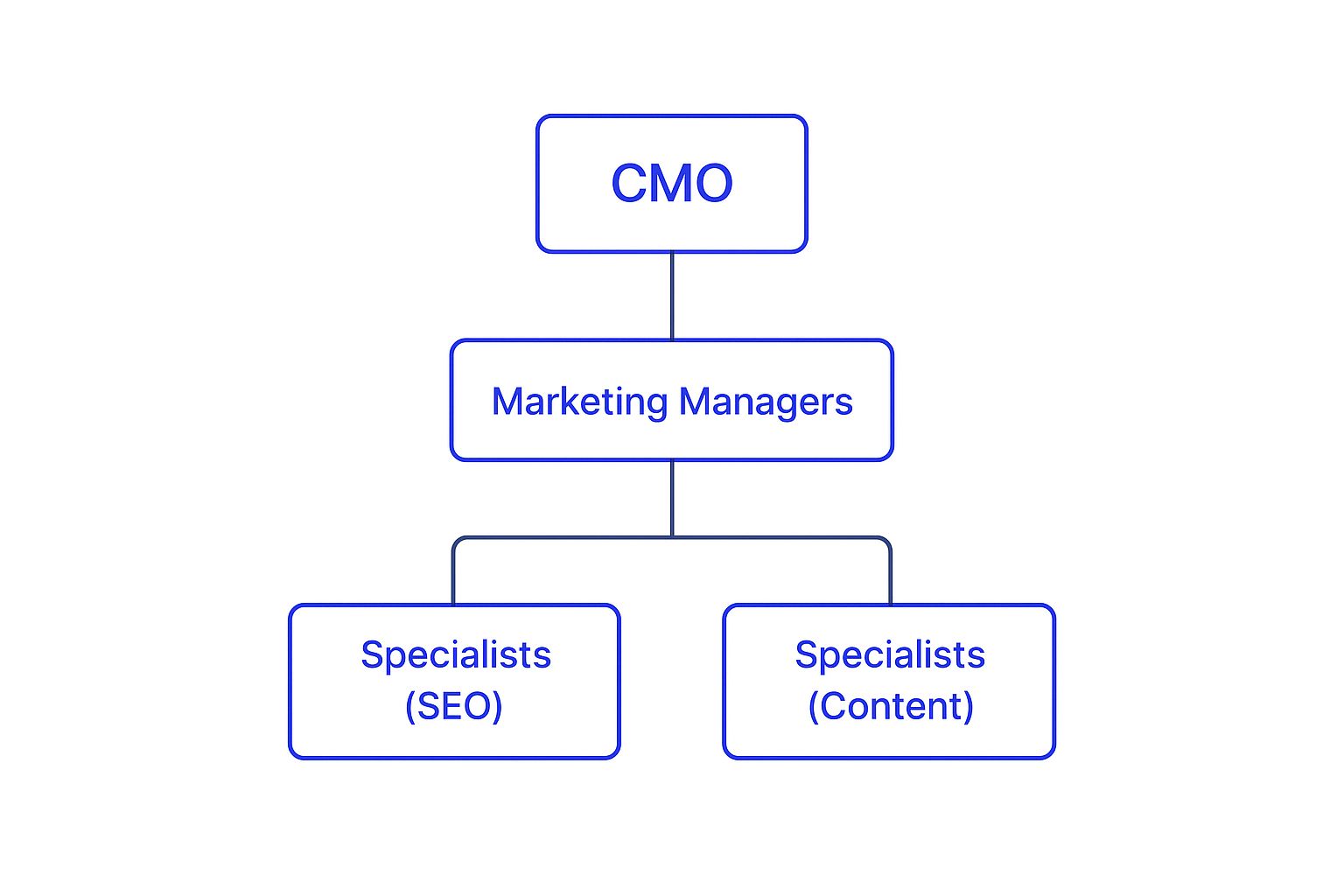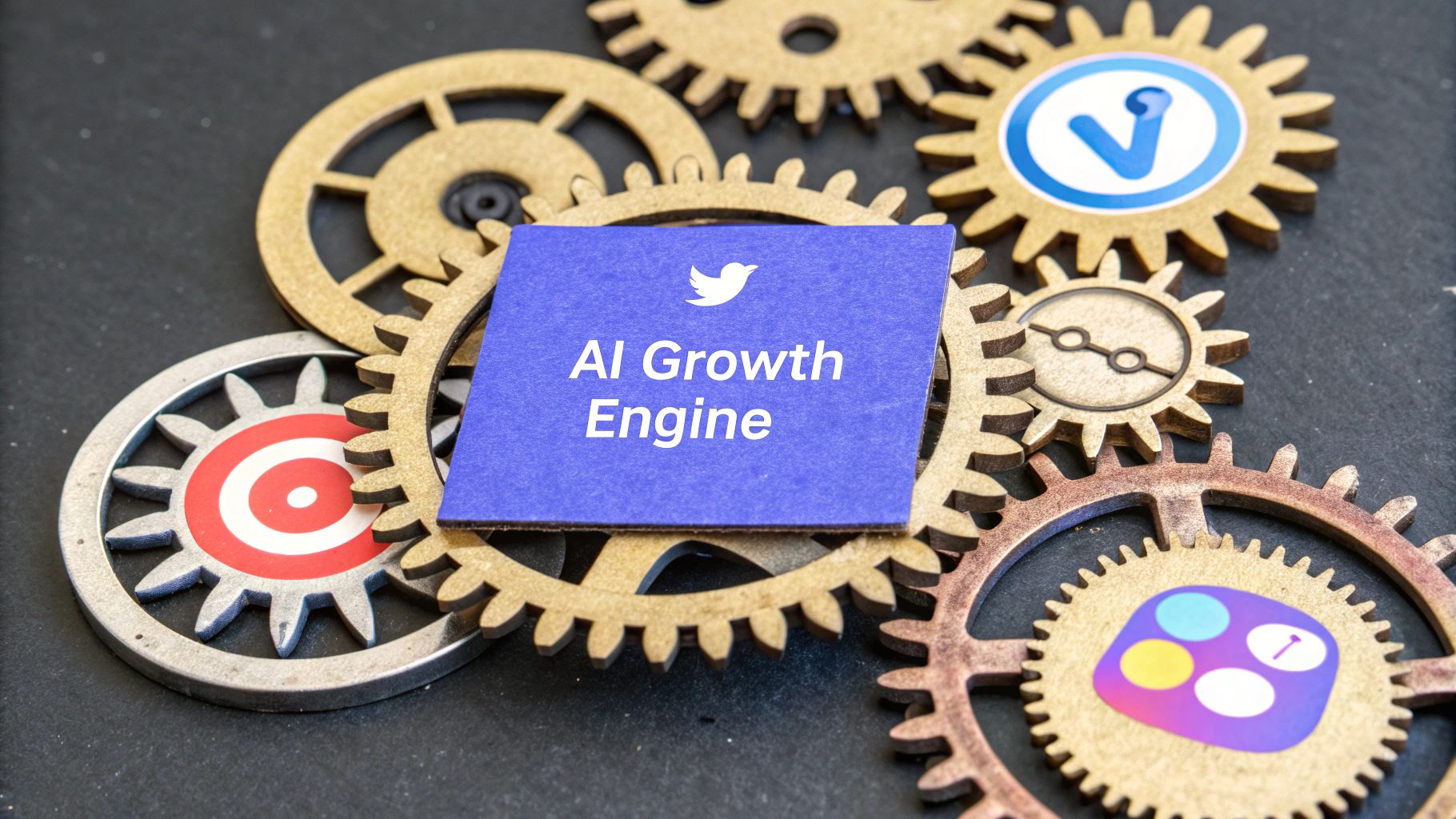A modern digital marketing team structure is so much more than just a handful of generalists trying to do it all. It’s a finely-tuned machine, a cohesive unit of specialized experts built for one thing: performance.
Think of it like a high-performance race car crew. You have distinct roles for strategy, SEO, content, and paid advertising, all working together to win the race. Without that deliberate organization, marketing efforts quickly become fragmented, inefficient, and honestly, a bit chaotic.
Why Your Marketing Team Structure Matters
Trying to build a successful marketing engine without the right blueprint is a recipe for disaster. A poorly defined team is like a sports team without a playbook—you might have talented players, but they lack the coordination needed to actually score. The real challenge for most businesses is designing a team that drives tangible, measurable results instead of just staying busy.
Let's go back to that high-performance race car. To build it right, you need a chief engineer (your Marketing Director or Strategist) who maps out the entire race plan. Then you bring in the specialized mechanics:
- The Engine Expert (SEO Specialist): This is the person obsessively fine-tuning the core engine for organic power and long-term, sustainable performance.
- The Aerodynamics Lead (PPC Manager): They’re all about speed and immediate results, constantly adjusting the car’s wings and spoilers for maximum downforce on every single turn.
- The Chassis and Bodywork Designer (Content Strategist): This expert ensures the car’s frame is strong and its design is compelling, creating the foundation that everything else is built upon.
The Impact of a Cohesive Structure
When these specialists work within a defined structure, everything just clicks. Communication flows, priorities are crystal clear, and everyone is pulling in the exact same direction. This isn't just about being more efficient; it's about making a real impact.
In fact, companies with a dedicated, well-structured marketing team execute campaigns 25% faster and maintain 40% more consistent brand messaging than those with a more haphazard approach.
A solid structure transforms a group of individual marketers into a powerful growth engine. It ensures every dollar spent and every hour worked contributes directly to your biggest business goals. The clarity that comes from an intentional digital marketing team structure allows for much better marketing resource management, guaranteeing you put your budget and talent where they’ll have the highest impact.
A well-designed team structure is the single most important factor in turning marketing from a cost center into a predictable revenue driver. It provides the clarity and accountability needed to execute complex strategies effectively.
Ultimately, defining your team's blueprint is non-negotiable for sustainable growth. It sets the rules for how campaigns are run, how success is measured, and how your brand's story is told to the world with a single, powerful voice.
The Core Roles of a High-Impact Marketing Team
A high-impact marketing team isn't just a collection of job titles. It's a carefully assembled group of specialists, each brought in to solve specific business problems. Think of it less like a traditional org chart and more like a high-performance growth machine, where every role is a critical component working together to turn strategy into real, measurable results.
To get a feel for how these roles fit into the bigger picture, especially in fast-moving industries, check out this great breakdown of the 9 Key Digital marketing Roles for Retail Leaders in 2025. Now, let's pull back the curtain on the key players who make modern marketing work.
The Strategic Conductor
At the very center of it all is the Digital Marketing Manager. This person is the conductor of your marketing orchestra. Their job is to make sure every specialist, from the SEO guru to the social media whiz, is playing in perfect harmony. They’re the ones who take big-picture business goals and translate them into concrete marketing campaigns, all while managing the budget and keeping an eye on the team's overall performance.
A great manager isn't just focused on one channel's metrics; they see how everything connects to the bottom line. They need to be part strategist, part project manager, and part data nerd, providing the leadership to keep the whole operation moving forward in the right direction.
The Visibility Architect
Next up is the SEO Specialist, who I like to call the visibility architect. Their entire mission is to make sure your brand gets found organically by the people who are actually looking for you. They live and breathe search engine algorithms, diving deep into keyword research, optimizing every piece of on-page content, and building a strong backlink profile to climb the search rankings. Their work is a long-game investment in sustainable traffic that pays dividends for years.
This role demands a unique mix of technical savvy, content instinct, and sharp analytical skills. A truly skilled SEO specialist doesn't just chase keywords. They get inside the head of the user to understand what they really want and build a website experience that both search engines and humans will love.
The Brand Storyteller
Every brand has a story, and the Content Strategist is the one who tells it. This role is so much more than just writing blog posts. They’re responsible for mapping out a comprehensive content plan that guides a customer from "Who are you?" all the way to "Take my money!" They decide what to create, whether it's a blog, a video, or an infographic, and figure out the best way to get it in front of the right eyeballs.
The Content Strategist ensures every single piece of content has a purpose. It might be to educate a potential customer, build trust in the brand, or drive a direct sale. They are the glue connecting what your brand wants to say with what your audience needs to hear.
This infographic gives you a clear visual of how these roles often fit together, from high-level leadership down to the specialists doing the day-to-day work.

As you can see, strategy flows down from the CMO, through managers, and into the hands of the specialists, creating a clear line of sight from objective to execution.
To get a clearer picture of how these roles function in practice, the table below outlines their core responsibilities and how their success is measured.
Essential Roles in a Modern Digital Marketing Team
| Role | Core Function | Key Responsibilities | Primary KPIs |
|---|---|---|---|
| Digital Marketing Manager | Strategic oversight and team leadership | Develops marketing strategy, manages budgets, oversees campaign execution, and reports on overall performance. | Return on Investment (ROI), Customer Acquisition Cost (CAC), Team Productivity |
| SEO Specialist | Drives organic traffic and visibility | Conducts keyword research, on-page/off-page SEO, technical audits, and content optimization. | Organic Traffic, Keyword Rankings, Conversion Rate from Organic Search |
| Content Strategist | Develops and executes the content plan | Creates content calendars, defines brand voice, manages writers, and maps content to the customer journey. | Engagement Metrics (Time on Page, Shares), Lead Generation, Content-Assisted Conversions |
| PPC Manager | Manages paid advertising campaigns | Creates and optimizes campaigns (Google Ads, Social Ads), manages ad spend, and conducts A/B testing. | Return on Ad Spend (ROAS), Cost Per Lead (CPL), Click-Through Rate (CTR) |
| Social Media Manager | Builds and engages the online community | Creates and schedules posts, manages community interactions, monitors brand mentions, and runs social campaigns. | Engagement Rate, Follower Growth, Social-Driven Traffic/Conversions |
| Data Analyst | Measures and analyzes marketing performance | Tracks campaign data, creates performance dashboards, identifies trends, and provides actionable insights. | Data Accuracy, Conversion Funnel Analysis, Marketing Attribution |
This breakdown shows just how distinct yet interconnected these roles are. Each has its own focus, but they all work toward the same ultimate goals: growth and revenue.
The Growth Accelerator
When you need results now, you turn to the PPC Manager (Pay-Per-Click). This is your growth accelerator. This specialist is in charge of all paid ad campaigns, whether on Google Ads or social media platforms. Their entire focus is on generating a stream of high-quality traffic and leads while squeezing every last drop of value out of the ad budget, a metric known as return on ad spend (ROAS).
A skilled PPC Manager is a master of turning ad spend into a predictable revenue machine. They are constantly testing, tweaking, and optimizing campaigns based on hard data, making them absolutely essential for breaking into new markets or ramping up lead generation quickly.
The Community Builder and Performance Navigator
To round out the core team, you need two more crucial players who connect your brand to its audience and make sense of all the data.
- Social Media Manager: This person is literally the voice of your brand online. They don’t just post updates; they build a genuine community, engage in real-time conversations, and protect the brand's reputation across all social channels.
- Data Analyst: I call this person the performance navigator. They are responsible for tracking, analyzing, and reporting on everything the marketing team does. They dig through the data to find the hidden insights that help the team make smarter decisions and prove the value of their work.
Put them all together, and you have a well-rounded digital marketing team structure that can handle the demands of a modern, multi-channel strategy. By understanding what makes each of these roles tick, you can start building a team that’s truly built for impact.
Choosing Your Marketing Team Model

Here's the thing: there's no single "best" digital marketing team structure. The right model for you is the one that fits your company's size, goals, and culture like a glove. It’s a bit like picking a vehicle—a zippy sports car is perfect for a fast solo trip, but you'll need a heavy-duty truck if you’re hauling a big load. What works depends entirely on the job at hand.
So, let's walk through the three main models that successful companies lean on. Each has its own flavor and is built for different business realities.
The Centralized Model
The Centralized Model is the classic, most straightforward setup. You have one, unified marketing department that handles everything for the entire company. All the specialists—your SEO guru, content wizard, PPC pro, and social media manager—report up to a single marketing leader, like a CMO or VP of Marketing.
Think of it like an orchestra. You’ve got all these talented musicians playing different instruments, but they all follow one conductor. This ensures every note works together to create a single, harmonious piece of music. That’s a centralized team in a nutshell.
This model is fantastic for keeping your brand voice and message locked in and consistent across every channel. It also kills redundancy and builds a tight-knit marketing culture where specialists can easily bounce ideas off each other.
Best for: Small to medium-sized businesses or companies that are focused on a single core product. This structure shines when brand consistency is your absolute top priority.
But, as a company scales, the centralized model can start to feel like a bottleneck. A single team trying to serve multiple departments or product lines can get stretched thin, slowing things down and losing touch with the unique needs of each group.
The Decentralized Model
Flipping the script completely, the Decentralized Model places marketing specialists directly inside different business units, product teams, or geographical regions. Essentially, each unit gets its own mini-marketing squad that reports to the head of that unit, not a central marketing chief.
Picture a fleet of independent food trucks. Each truck has its own chef and a unique menu designed for the specific neighborhood it serves. They might all be under the same parent brand, but they operate autonomously to nail their local appeal.
The huge win here is agility and deep market focus. Marketers embedded in a unit get to know its customers and challenges inside and out, letting them launch super-relevant and responsive campaigns. It’s the perfect play for massive, diverse corporations where a one-size-fits-all approach would fall flat.
The downside? You risk a fragmented brand experience. Without that central conductor, messaging and visuals can start to drift apart across different units. This model can also lead to duplicated work and higher costs as each team invests in its own set of tools and resources.
The Hybrid Model
Trying to get the best of both worlds, many companies land on a Hybrid Model. This approach blends a central marketing team with specialists who are also embedded within specific business units.
It’s a lot like a professional sports franchise. There's a central front office managing the league-wide brand, big sponsorships, and overall game plan. At the same time, each individual team has its own dedicated coaches and staff focused on winning their specific games.
In a hybrid digital marketing team structure, the central team usually handles the big-picture brand strategy, core technology, and foundational content. The embedded specialists then take that framework and adapt it to execute campaigns tailored to their unit's unique needs. This creates a powerful balance of strategic consistency and tactical flexibility. It's often the most effective model, but it's also the most complex to pull off.
How to Scale Your Team as Your Business Grows

A digital marketing team isn't something you build once and forget about. It's a living, breathing part of your company that has to evolve as you grow. The scrappy, do-it-all structure that gets a startup off the ground will inevitably buckle under the pressure of enterprise-level goals.
Building a team that can scale is less about who you hire and more about when you hire them.
Thinking about your team's journey in clear phases gives you a roadmap. It lets you be proactive, ensuring your marketing engine is always powerful enough for the next leg of the race, instead of constantly trying to fix a machine that's lagging behind.
The Startup Stage: The Versatile Generalist
In the very beginning (think 1-10 employees), your "marketing team" is often just one person. This is your marketing Swiss Army knife—a true generalist who can juggle a bit of everything. One day they're writing blog posts and managing social media, the next they're running small ad campaigns and sending email newsletters.
The goal here isn't to master a single channel. It's all about experimenting to see what works. This lone marketer, often called a "T-shaped" marketer, knows a little about a lot of things and is really good at one or two. Their agility is their biggest strength, letting the company test ideas quickly without sinking cash into a bunch of specialized roles.
The Growth Stage: Building a Specialized Core
Once your business starts to gain real traction and scale (usually in the 50-500 employee range), that one-person-band approach starts to fall apart. The channels that showed promise now need real expertise to drive serious results. This is your cue to start building a core team of specialists.
Your first few specialist hires should be aimed squarely at the channels that are already delivering the best ROI. For most businesses, this means bringing on:
- An SEO Specialist: To build a reliable stream of organic traffic and capture long-term search demand.
- A Content Strategist: To shape your brand story and fuel the inbound marketing machine. As you expand, you'll need a clear plan for how to scale your content marketing effectively.
- A PPC Manager: To hit the accelerator on growth with targeted, paid ad campaigns.
During this phase, the digital marketing team structure starts to take shape. Your original generalist might step into a Marketing Manager role, coordinating the work of the new specialists. You're shifting from a strategy of breadth to one of depth, putting experts in charge of the areas that matter most.
This leap from generalist to specialist is probably the most important transition a marketing team will ever make. It's the moment marketing stops being a series of one-off experiments and becomes a predictable, strategic driver of growth.
The Enterprise Stage: Developing Sub-Teams and Leadership
By the time your company hits the enterprise level (500+ employees), your marketing needs have become way more complex. That core team of specialists, while great, can't handle the sheer volume and intricacy of the work anymore. At this point, you need to build teams within the team.
The size of a digital marketing team changes dramatically with company size. For startups with 1–10 employees, 1–3 versatile marketers are typical. As companies grow to 50–500 employees, that number often jumps to 5–10 specialists. Massive enterprises can have marketing departments with 20 or more highly focused roles. You can discover more insights about scaling your team on searchsolutiongroup.com to see more data on this.
This next stage of evolution usually follows a clear path:
- Hire a Director or VP of Marketing: You need a leader who can set high-level strategy, manage a serious budget, and make sure marketing's goals are perfectly aligned with the C-suite's vision.
- Create Specialized Sub-Teams: Your solo SEO Specialist is now the Head of SEO, leading a team that might include a technical SEO and a link-building specialist. Your Content Strategist might now manage a team of writers, editors, and videographers.
- Add Essential Support Roles: You'll also need people in Marketing Operations to manage your growing list of software and Data Analysts to dig deep into performance insights across every channel.
By thoughtfully guiding your team through these phases, you ensure your marketing function is always the right size and shape to not just support your company's growth, but to actively drive it.
Creating an Agile and Data-Driven Culture
Having the perfect digital marketing team structure on paper is a great start, but it's only half the battle. A brilliant blueprint means nothing without the right culture to bring it to life. How your team actually operates—the way they collaborate, adapt, and make decisions—is what will ultimately set you apart.
The two pillars of a high-performance marketing culture are agility and a data-first mindset. An agile team doesn’t just react to change; it anticipates it. Think of them less like a rigid factory assembly line and more like a special ops team, ready to pivot in a heartbeat based on real-time intelligence from the field.
Embracing Agile Marketing Practices
Agile marketing borrows its core ideas from the fast-paced world of software development to push campaigns forward with serious momentum. Instead of planning massive, long-term campaigns that culminate in a single "big bang" launch, agile teams work in short, focused bursts called sprints.
These sprints usually last two to four weeks and are laser-focused on hitting a specific, measurable goal. To keep everyone on the same page, teams hold brief daily "stand-up" meetings to track progress and clear any roadblocks immediately. This cycle of short sprints allows for constant learning and optimization on the fly.
Breaking Down Silos for True Collaboration
One of the biggest killers of marketing effectiveness is the silo. When your SEO specialist and your content strategist are operating in their own separate worlds, you end up with disjointed campaigns that never reach their full potential. Real agility demands a culture of radical collaboration where information flows freely between every member of the team.
This means your PPC manager should be sharing keyword performance data with the content team to inspire their next blog post. At the same time, the social media manager’s insights on what’s resonating with your audience should be feeding back into the SEO team’s strategy. Getting this level of teamwork right is essential, and having the right tools makes all the difference. To dive deeper, check out our guide on the best marketing collaboration software to keep your team connected.
An agile, collaborative culture transforms a team from a group of individual specialists into a unified growth engine. It creates an environment where the whole is truly greater than the sum of its parts.
Championing Data-Driven Decisions
The second pillar, a data-driven mindset, is all about replacing guesswork with hard evidence. In this kind of culture, opinions are always welcome, but data ultimately wins the argument. Every strategy is treated like a hypothesis—something to be tested, measured, and improved based on real performance, not just gut feelings or how things were done last year.
A core part of this is consistently measuring marketing campaign effectiveness. Your team needs to be obsessed with the metrics that truly matter, like Customer Acquisition Cost (CAC), Return on Ad Spend (ROAS), and conversion rates.
This data-first approach isn't just about reporting on what already happened; it's about using analytics to predict what will happen next and making proactive adjustments. This level of adaptability has become foundational to modern digital marketing. In fact, companies with agile, data-driven teams that quickly adjust strategies based on real-time data outperformed competitors by 15–20% in campaign ROI. You can read the full research about these findings on marketing team optimization.
By building a culture that thrives on change and is guided by data, you create a marketing department that consistently delivers exceptional results.
Frequently Asked Questions

As you start piecing together your digital marketing team, you're bound to have questions. It’s a complex puzzle. Here are some straightforward answers to the questions we hear most often, designed to give you clarity and help you build a team that’s ready to win.
When Should I Hire My First Marketing Specialist?
There's a "tell" for this. It's that moment when a critical, high-impact channel has grown beyond what a generalist can handle. You'll know it's time when the day-to-day tasks for that channel are so overwhelming that no one has time for actual strategic thinking.
For most businesses, that first specialist hire is an SEO or Content Marketing Manager. These roles are foundational. They build long-term, sustainable growth that you can't get from just dabbling. It’s less about a calendar date and more about realizing a channel’s potential is being capped by a lack of focused expertise.
How Do You Structure a Marketing Team For a Small Business?
Keep it lean and mean. Start with a versatile "T-shaped" marketer. This is your jack-of-all-trades who also happens to have deep expertise in one or two specific areas—the perfect blend of breadth and depth.
As you grow, look at which channels are really moving the needle and bringing in the best ROI. Hire specialists to own those channels. A lot of small businesses also find a smart balance by outsourcing the really technical or time-consuming stuff.
A common and effective approach is to keep core functions like content and brand in-house while partnering with freelancers or an agency for specialized needs like PPC management or technical SEO. This gives you expert support without the full-time overhead.
What Is The Most Important Role on a Digital Marketing Team?
This might be controversial, but if you have to pick just one, it's the Digital Marketing Manager or Strategist. Think of this person as the orchestra conductor. They ensure every specialist—from the SEO whiz to the social media guru—is playing in harmony and working toward the same business goals.
Without that strategic oversight, you just have a group of talented individuals working in silos. Their work might be great on its own, but it won't have the combined force needed for massive growth. The manager is the glue that turns individual efforts into a powerful, unified marketing engine, making the entire digital marketing team structure click.
Ready to streamline your team's workflow and supercharge your social media presence? PostSyncer provides the AI-powered tools your team needs to collaborate, schedule content, and analyze performance effortlessly. Discover a smarter way to manage social media by starting your free trial at https://postsyncer.com.















